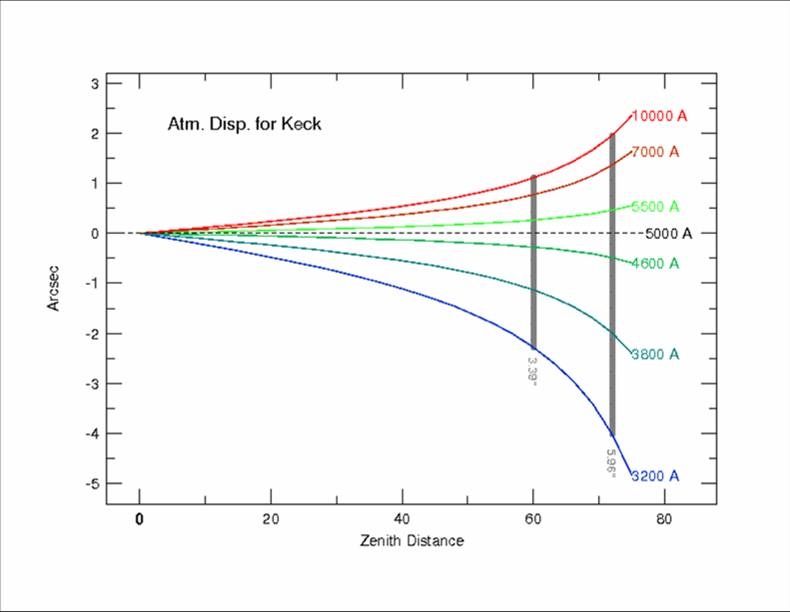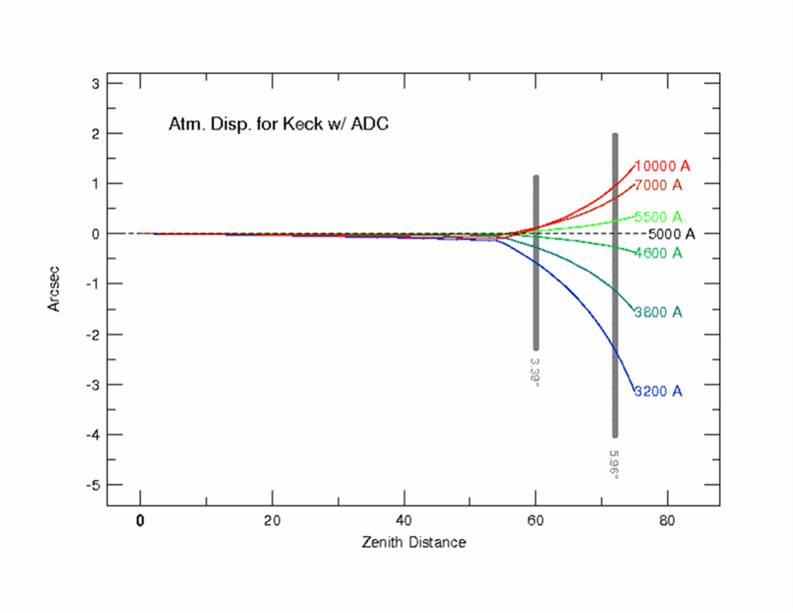ADC Characteristics
Wavelength Range
The Cassegrain ADC is designed to operate over the wavelength range 3200 Angstroms to 10,000 Angstroms, completely covering the useful operating range of LRIS.Compensation
The first figure below shows the different refraction for LRIS in without any dispersion compensator. At zenith (zenith distance=0°, elevation=90°, airmass=1.0) the light is not refracted and thus the dispersion is zero. At an zenith distance of 60° (elevation of 30° , airmass=2.0) the differential refraction between light at the UV and IR limits is over 3 arcsec, and at zenith distance of 72° the differential refraction is nearly 6 arcsec.

The following figure shows the effect of enabling dispersion compensation with Cass ADC. The differential refraction is negligible from zerith to zenith distance of 55° and is still well under 1.0 arcsec at 60° over the full wavelength range from 3200 to 10,000 Angstroms.

Elevation Range
The designed operating range for the Cass ADC is from zenith (elevation 90°) to airmass=2.0 (elevation 30°). As shown in the preceding figure, the dispersion over the entire operating range of LRIS is under 1.0 arcsec over this entire range. Cass ADC can be used at elevations below 30° but will be unable to correct fully for the effects of differential refraction. However, the image quality produced with Cass ADC should still be far superior to that without.Throughput
The Cass ADC was designed to deliver throughput of 95% or greater over the full operating wavelength range of LRIS, with higher throughput in the red. Complete information is contained in a technical note by Drew Phillips of UCO/Lick.Ghosting
Due to its excellent SolGel anti-reflection coatings, the Cass ADC shows very little ghosting. This technical note from Drew Phillips describes the expected ghosting characteristics.Telescope Compensations
The Cass ADC module modifies the telescope focal plane slightly. The Keck I telescope's control system (DCS) accounts automatically for these effects:- Pointing. The presence of the Cass ADC optics changes the pointing of the telescope slightly. The image shift varies as a function of the prism separation and must be continuously calculated by the DCS.
- Focus. To keep the telescope focal plane coincident with the LRIS slitmask plane, the secondary mirror position must be changed. Again, this correction is a function of the prism separation and thus DCS must regularly compute and apply the needed correction.
Plate Scale Change
The Cass ADC changes the image scale at the LRIS focal plane by a small but measurable amount (less than 1 arcsec across the 8 arcmin field of view). If not accounted for, this effect would case slit losses due to target/slit misalignment for slitmask observers. Hence, two implications for those using slitmasks with LRIS-ADC:- Observers should not use LRIS masks designed for use without the Cass ADC module when observing with LRIS-ADC.
- Observers using slitmaks must download a revised version of the slitmask design software for LRIS. Judy Cohen has released version 3.09 of her AUTOSLIT package, and Drew Phillips has created a similarly corrected version of his FABMASK software for LRIS mask design.
Polarimetric Effects
Tests with the LRIS polarimeter module and the Cass ADC shows that the impact of the Cass ADC on polarimeter observations is very small. Full details are provided in KITN 0004.Send questions or comments to: